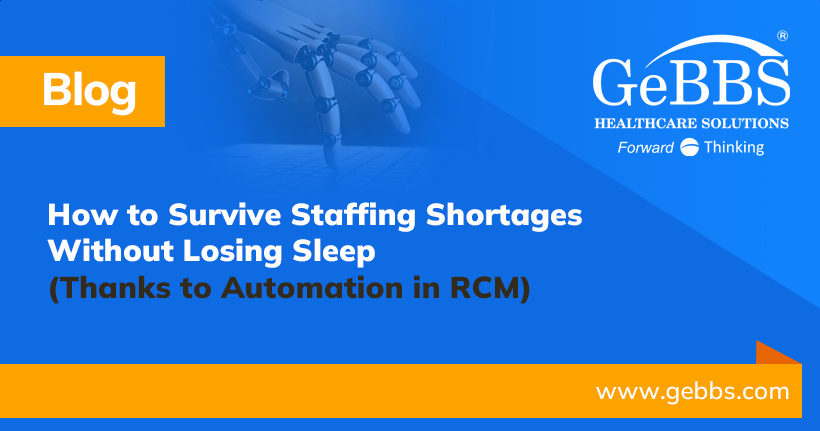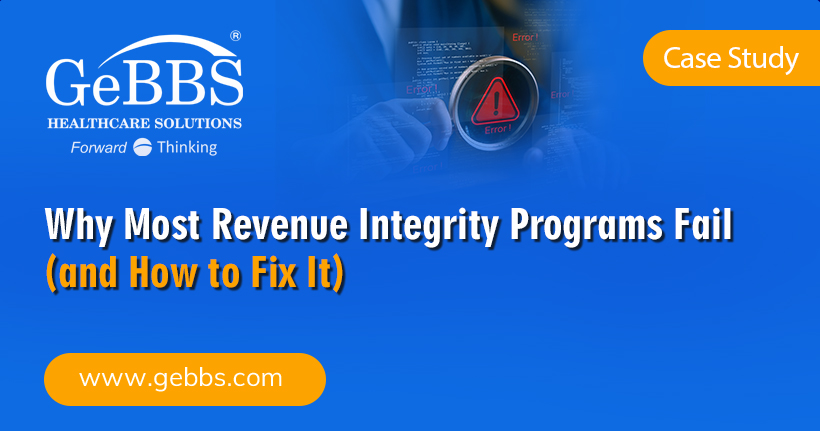You walk into the office, grab your coffee, and—bam. Another team member is out. Again. Whether it’s a better job offer or just life happening, you’re left scrambling to plug the gap…and wondering how long your team can keep this up.
Maybe you’ve caught yourself thinking, “We’re barely hanging on as it is. How are we supposed to keep the revenue flowing short-staffed?” That feeling of being stuck between rising claim volumes and a shrinking workforce is real. You’re doing your best with what you’ve got, but it can feel like you’re constantly bailing water out of a leaky boat. And it needs to stop.
Automation in RCM can give your team back its breathing room. Not only will it bring a little peace of mind back into your day, but it helps protect your cash flow too. We’ll discuss how shortly, but first, let’s look at some of the reasons why you may have written off automation.
3 Common Myths About Automation in RCM
Let’s be honest, automation in RCM has a bit of a reputation problem. Maybe someone on your team is skeptical. Maybe you are. That’s understandable. When you’ve been doing things a certain way for years, anything new can feel risky. But a lot of what gets said about automation simply doesn’t hold up.
“We’ll lose jobs.” This one’s a biggie. And while it’s true that automation will likely phase out some roles, it will also create new ones and free up your staff to focus on what really matters. Think of it like a digital assistant that handles the repeatable, mindless tasks. That way, your team can focus on the high-value work only they can do: problem-solving, customer interactions, and navigating tricky payer issues. Ironically, automation often helps retain staff by reducing burnout and making the job more rewarding.
“It’s too expensive.” Sure, most tools come with upfront costs. But compare that to the price of constant overtime or retraining new employees every few months. Automation doesn’t call in sick. It doesn’t quit. It doesn’t get overwhelmed. In many cases, the ROI shows up faster than you’d expect.
“It’s hard to implement.” While it used to be, it’s not anymore. Today’s automation tools are modular, meaning they can integrate with your existing systems without forcing you to replace your entire setup. Many platforms are cloud-based, customizable, and user-friendly. And with the right partner, implementation can feel more like collaboration than disruption.
Where Automation Makes the Biggest Difference in Your Revenue Cycle
So where should you start? Some parts of the revenue cycle see greater gains from automation in RCM than others. Here’s where the payoff tends to be biggest.
Claim Status Checks and Follow-Up
If your team spends hours each week logging into multiple payer portals to check claim statuses, automation can streamline the process. Bots can pull that data automatically across payers, in real time.
The result? Staff can skip the mindless clicking and spend their time actually resolving issues. Imagine going from chasing down statuses to proactively tackling denials before they become backlogs. That’s a win.
Eligibility and Benefits Verification
Front-end errors lead to back-end delays. But when your front desk is short-staffed, it’s easy for details to slip through the cracks.
Automated eligibility verification tools can run checks before the patient even walks in the door. That means clean claims go out the first time and fewer denials come back. How does that impact your staff? They’re no longer scrambling to fix preventable errors after the fact.
Denial Management
Denials are one of the most resource-draining parts of the revenue cycle. Often, they sit untouched until someone has time to dig in. By then, appeal windows may have closed or recurring issues (like coding errors or payer-specific rejections) may have gone unnoticed.
Automation in RCM helps you get ahead of all that. Smart tools can identify trends across denials, trigger workflows for appeals, and even prioritize which denials to tackle first. Simply put, you don’t have to wait until a pileup happens to respond. You can address issues as they emerge.
Payment Posting and Reconciliation
When someone’s out unexpectedly, this is one of the first areas to feel the impact. Manual posting gets backed up fast. And reconciling payments across systems becomes a game of guesswork.
Automated payment posting tools speed up the process and reduce errors. Some platforms even match remits and payments automatically, flagging discrepancies as they arise. The end result is higher accuracy and cash flow continuity.
What to Look for in an RCM Automation Partner
Not all automation solutions are created equal. And not every vendor understands the unique pressure RCM teams face. When evaluating a partner, here’s what to keep top of mind:
- Integration with existing platforms: The best tools fit your current ecosystem. You shouldn’t have to rebuild your tech stack just to automate.
- Real-time dashboards and visibility: Automation shouldn’t be a black box. Look for tools that give you clear insight into what’s running, what’s working, and what needs attention.
- Customizable workflows: Every organization has its own rhythm. The right solution adapts to your processes, not the other way around.
- Proven experience in healthcare RCM: While tech is important, you also need a partner who understands the nuances of claims, compliance, and revenue flow. That kind of expertise directly impacts results. Ask your prospective vendor for case studies and performance data to ensure they can deliver.
Automation in RCM won’t solve every staffing issue overnight. But it can take some of the pressure off. It gives your team a chance to catch up and focus on what truly matters. And in today’s environment, that bit of cushion might be the most valuable thing of all.
Let Your Revenue Cycle Breathe Again
The chaos of constant staffing gaps doesn’t have to be your normal. You don’t have to walk into work wondering who’s out or how your team will manage to keep up.
Imagine instead walking into a quieter kind of morning. Your claim statuses have already been checked. Denials are being flagged and sorted automatically. Payments are posted while you sip your coffee. And your team? No longer are they drowning in busywork. Instead, they’re focused and maybe even ahead for once.
That’s what automation in RCM makes possible. It gives you space to focus on strategy and long-term growth. And you can finally stop holding your breath every time someone calls in sick. Does your team feel stretched thin? GeBBS has got you covered. Our automation tools handle the tedious tasks, like claim status checks and payment posting, so your staff doesn’t have to. No clunky system overhauls. No steep learning curves. Our automation tools are compatible with major EHRs and revenue cycle platforms, and fit seamlessly into your existing workflow. You’ll cut down on errors, speed up processes, and keep cash flowing—even when you’re short-staffed. Think of it as giving your revenue cycle a second set of hands. Contact us today to learn more.






